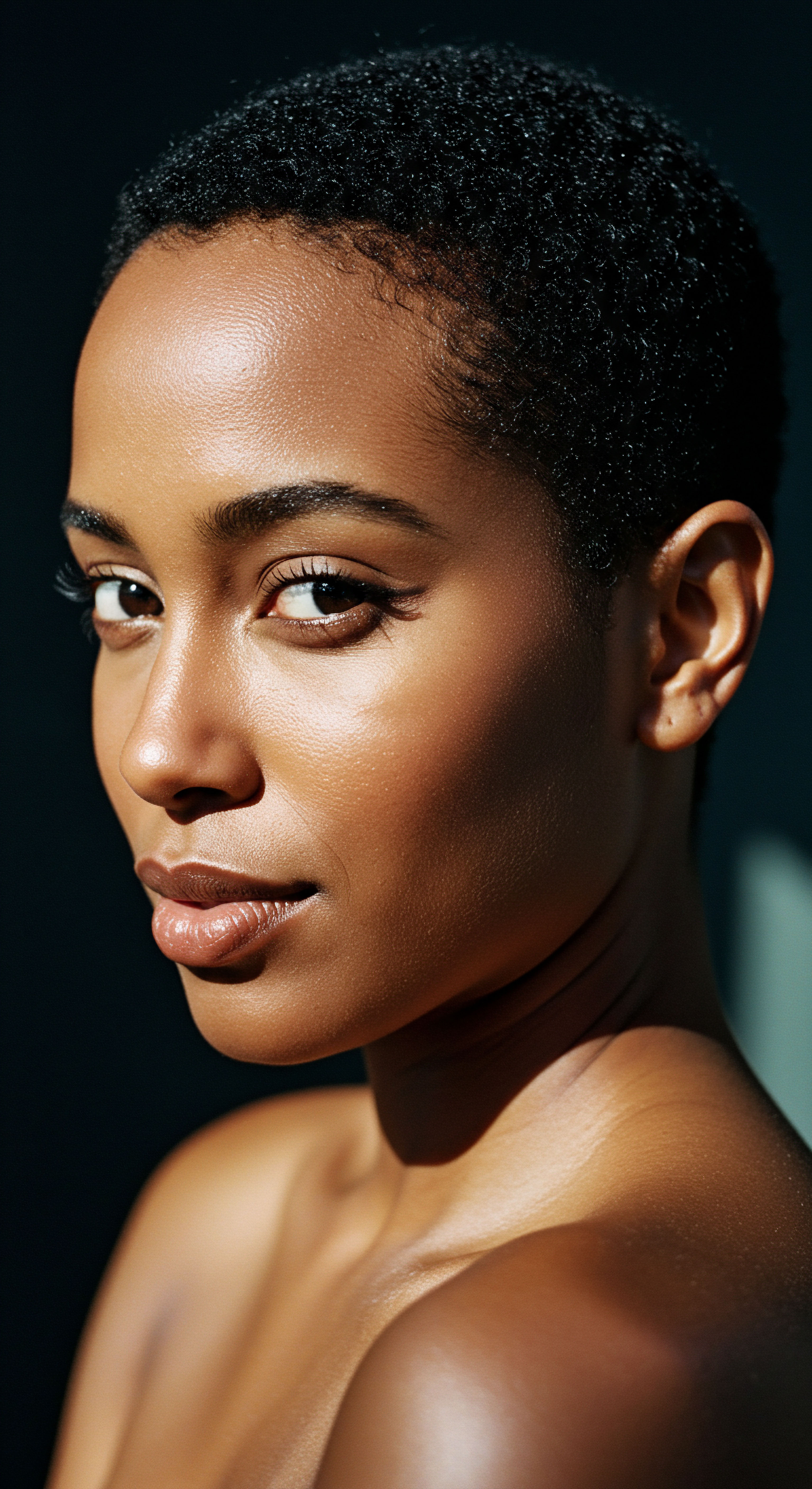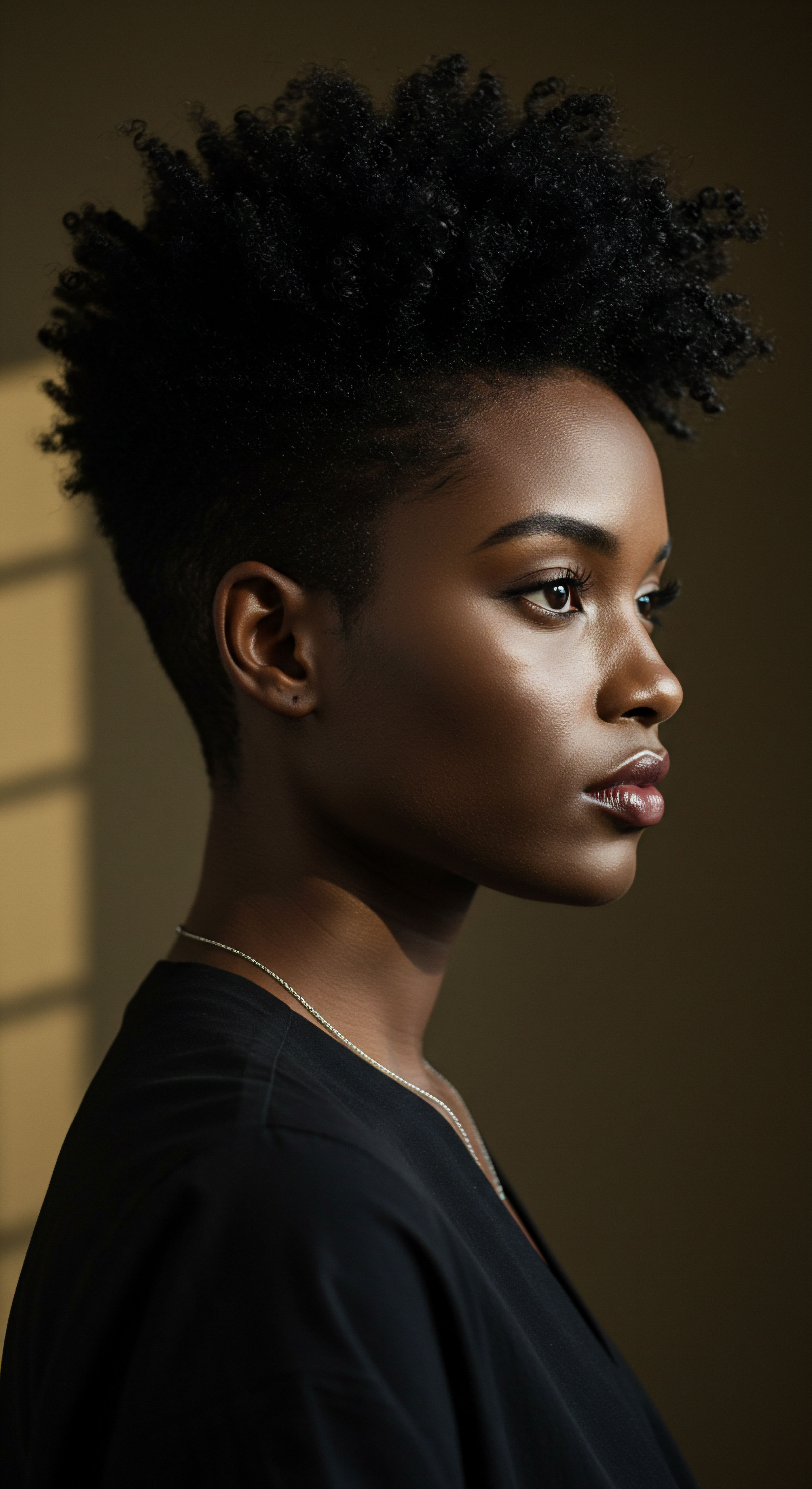
Roots
There exists a quiet language within our strands, a whisper of heritage and possibility that often goes unheard amidst the clamor of daily life. For many, the perception of hair density — that feeling of fullness, the visual richness of a healthy crown — is a deeply personal metric, tied to identity and the very story written upon our scalp. It is a natural inclination to ponder what truly shapes this aspect of our being, to seek the foundational truths that govern the lushness or sparsity we observe. What ancient blueprints, what cellular conversations, truly determine the abundance of each hair follicle?
The intricate world beneath the scalp holds many secrets, yet one element stands as a profound architect of hair density ❉ our genetic inheritance. From the very moment of conception, a complex dance of inherited traits begins, setting the stage for the number of hair follicles we possess, their potential size, and the very rhythm of their growth cycles. This biological legacy dictates the inherent capacity for density, laying down the initial framework upon which all subsequent influences will act. Understanding this deeply rooted aspect is akin to tracing the very lines of a hand, revealing a unique map of potential.
Our genetic inheritance serves as the profound architect of hair density, dictating the inherent capacity for follicular abundance.

The Follicular Blueprint
Each individual arrives with a predetermined number of hair follicles, tiny organs nestled within the skin. These follicles are not created anew throughout life; rather, their quantity is largely fixed before birth. The size and shape of these follicles, too, are influenced by our genetic makeup, playing a significant part in the caliber and overall appearance of individual strands. A greater number of follicles naturally translates to a higher potential for density, while the diameter of each hair contributes to the overall visual fullness.
Consider the variations seen across different populations and hair textures. The magnificent diversity of textured hair, from tightly coiled strands to looser curls, is a testament to the broad spectrum of genetic expression. While a single strand of fine hair might possess a delicate diameter, a collection of such strands can collectively create a dense appearance if the follicle count is high.
Conversely, fewer follicles, even producing thick strands, may result in a less dense overall look. This interplay between strand thickness and follicle count is a dance orchestrated by our genes.

How Many Follicles Do We Possess?
The human scalp, on average, hosts approximately 100,000 to 150,000 Hair Follicles. This range is not arbitrary; it is a genetically influenced spectrum. While some individuals are born with a predisposition for a higher number of follicles, others naturally have fewer.
This innate count establishes a baseline for hair density that no external product or practice can fundamentally alter. We can optimize the health and growth of the existing follicles, but we cannot conjure new ones where none exist.
- Follicle Count ❉ The number of individual hair-producing structures on the scalp, a primary genetic determinant.
- Hair Caliber ❉ The thickness or diameter of an individual hair strand, also largely genetically predetermined.
- Growth Cycle Phases ❉ The duration of anagen (growth), catagen (transition), and telogen (resting) phases, influenced by genetic programming.

Understanding Hair Growth Cycles
Hair does not grow continuously; it follows a cyclical pattern, a biological rhythm that dictates its life span. Each follicle independently cycles through three main phases ❉ anagen, catagen, and telogen. The length of the anagen, or active growth, phase is particularly impactful on hair density.
A longer anagen phase allows hair to grow to a greater length, contributing to the visual bulk and perceived density. This duration, too, carries a strong genetic signature.
When the anagen phase is genetically predisposed to be short, hair may struggle to achieve significant length, impacting the overall impression of density, even if the follicle count is respectable. Conversely, individuals with a long anagen phase often possess the capacity for very long, dense hair. This natural timing of growth and rest is a silent partner in the story of our hair’s abundance.
| Phase Anagen |
| Description Active growth phase, where hair cells rapidly divide. |
| Genetic Impact Determines maximum hair length and overall density potential. |
| Phase Catagen |
| Description Short transitional phase where hair growth stops. |
| Genetic Impact Brief, genetically timed regression of the follicle. |
| Phase Telogen |
| Description Resting phase before the hair sheds and a new cycle begins. |
| Genetic Impact Duration influences hair retention before shedding. |
| Phase The duration and characteristics of each phase are significantly shaped by an individual's inherited genetic code. |

Ritual
Having acknowledged the profound genetic underpinnings of hair density, our gaze now turns to the practices, the mindful gestures, and the deliberate choices that can either honor or diminish this inherited potential. It is here, in the realm of ritual, that we step from understanding what is given to cultivating what can be. The daily and weekly practices we adopt, the products we choose, and the very way we interact with our strands are not mere habits; they are a conversation with our hair, a series of actions that can significantly influence the health and vitality of each follicle, thereby supporting the expression of our inherent density. This exploration moves beyond the static blueprint, inviting us into the dynamic artistry of care.
While genetics sets the stage, the consistent, thoughtful care of our hair and scalp acts as the skilled hand that tends the garden. A healthy scalp environment is paramount for robust hair growth, and our rituals play a direct role in maintaining this delicate ecosystem. From cleansing to conditioning, from styling to protecting, each step holds the capacity to either nurture or hinder the hair follicles’ ability to produce strong, healthy strands. This section seeks to illuminate how these purposeful actions contribute to the perceived and actual density of our hair, making the most of the genetic endowment.

Nourishing the Scalp Ecosystem
The scalp is more than just skin; it is the living soil from which our hair springs. Its health directly impacts the density and quality of hair that emerges. Rituals centered on scalp care are therefore foundational.
Regular, gentle cleansing helps remove product buildup, excess sebum, and environmental impurities that can clog follicles and impede healthy growth. Conversely, harsh cleansers or infrequent washing can lead to inflammation or an imbalance in the scalp’s delicate microbiome, creating an environment less conducive to thriving hair.
The act of massaging the scalp, often incorporated into washing or oiling rituals, is not merely a soothing gesture. It can stimulate blood circulation to the hair follicles, delivering essential nutrients and oxygen. This gentle encouragement of blood flow can help support the metabolic activity of the follicles, promoting a healthier growth cycle and potentially aiding in the maintenance of density.
The choice of products, too, holds significance. Opting for formulations that respect the scalp’s natural pH and contain nourishing ingredients can make a tangible difference.
Consistent, thoughtful care of our hair and scalp acts as the skilled hand that tends the garden, directly impacting density.

The Art of Cleansing and Conditioning
The selection of shampoos and conditioners, particularly for textured hair, requires discernment. Products that are too stripping can dehydrate the scalp and hair, leading to breakage and a diminished appearance of density. Instead, embracing moisturizing cleansers and conditioners that replenish the hair’s natural oils and fortify the strands is a ritual of replenishment.
- Gentle Cleansing ❉ Choose sulfate-free or low-lather cleansers that purify without stripping natural moisture.
- Deep Conditioning ❉ Regular deep conditioning treatments provide intense hydration and protein, strengthening strands from within.
- Scalp Treatment ❉ Incorporate scalp serums or oils that target specific concerns like dryness, flakiness, or inflammation.

Protective Styling and Manipulation
Beyond cleansing, the way we style and manipulate our hair profoundly influences its retention and, by extension, its apparent density. Textured hair, with its unique structural properties, can be particularly vulnerable to breakage if handled improperly. Protective styles, such as braids, twists, or buns, serve as a shield against environmental stressors and excessive daily manipulation, allowing the hair to rest and grow without constant friction or tension.
The frequency and intensity of manipulation are often overlooked factors. Constant brushing, tight styling, or the use of excessive heat can weaken the hair shaft, leading to breakage at various points along the strand. This breakage, while not affecting the number of follicles, can significantly reduce the overall volume and length, giving the impression of decreased density. A mindful approach to styling, prioritizing gentle techniques and allowing hair periods of rest, becomes a powerful ritual for preserving density.
Consider the historical and cultural significance of protective styles across various traditions. Many communities have long understood the wisdom of safeguarding their strands, not only for aesthetic appeal but for the health and longevity of the hair itself. This ancestral knowledge speaks to a deep understanding of hair’s delicate nature and the need for deliberate, protective rituals.

Relay
Having traversed the foundational landscape of genetics and the applied artistry of daily ritual, we now shift our focus to the deeper, often unseen currents that relay messages to our hair follicles, shaping their performance and ultimately, our hair’s density. This journey delves into the intricate interplay of internal biological systems, environmental exposures, and even psychological states, revealing how a symphony of factors can either support or challenge our hair’s innate potential. It is a space where the science of the body meets the art of living, offering a more complete understanding of what truly influences the perceived richness of our hair. Here, we peel back layers to uncover less obvious, yet profoundly impactful, contributors to hair density.
The notion of hair density, seemingly straightforward, is in truth a dynamic outcome of continuous cellular communication and physiological balance. While the number of follicles is fixed, their ability to consistently produce healthy, substantial strands is subject to a complex network of influences. This section ventures into these less-explored territories, presenting a holistic perspective that integrates the microscopic world of cellular signaling with the macroscopic realities of our environment and wellbeing. It is within this confluence of forces that we discover the true complexity of hair density, moving beyond simplistic explanations to embrace a multi-dimensional understanding.

Hormonal Orchestration and Follicular Sensitivity
Beyond genetics, hormonal fluctuations represent a powerful conductor in the orchestra of hair growth and density. Androgens, particularly dihydrotestosterone (DHT), play a significant, often misunderstood, role. While essential for certain bodily functions, an excess or an increased follicular sensitivity to DHT can lead to miniaturization of hair follicles, a process where follicles shrink over time, producing progressively finer and shorter hairs, eventually ceasing production altogether. This is a primary mechanism in common forms of hair thinning, such as androgenetic alopecia.
The impact of DHT sensitivity is particularly pertinent in understanding density changes across different populations. While not exclusive to any one group, genetic predispositions for increased DHT sensitivity vary. This sensitivity can cause even a normal level of androgens to have a detrimental effect on genetically vulnerable follicles, leading to a noticeable reduction in density over time. This process underscores how internal biological responses can override or diminish an otherwise healthy genetic follicular count.
Hormonal fluctuations, especially the impact of DHT on sensitive follicles, represent a powerful, often misunderstood, conductor in the orchestra of hair growth and density.

The Silent Influence of Chronic Inflammation
A less commonly discussed, yet profoundly impactful, factor influencing hair density is systemic low-grade chronic inflammation. This persistent, underlying inflammation throughout the body can silently disrupt numerous physiological processes, including the delicate environment surrounding hair follicles. Research suggests that chronic inflammation can contribute to follicular miniaturization and premature entry into the telogen (resting) phase, thereby reducing the number of active growing hairs and diminishing overall density.
For instance, a study published in the Journal of Investigative Dermatology explored the link between inflammation and hair loss, indicating that certain inflammatory cytokines can directly inhibit hair growth and promote catagen entry. This research highlights how systemic conditions, even those not overtly presenting as hair disorders, can exert a significant, subtle pressure on hair follicle health. The implications extend to dietary choices, stress management, and exposure to environmental toxins, all of which can contribute to the body’s inflammatory burden. This deep biological interaction reveals that the journey to vibrant density is not merely external but deeply rooted in the body’s internal harmony.

Nutritional Symbiosis and Environmental Stressors
The building blocks for healthy hair—proteins, vitamins, and minerals—are supplied through our diet. A sustained deficiency in key nutrients can lead to a reduction in hair quality and, subsequently, density. Iron, zinc, biotin, and specific amino acids are particularly vital for the robust functioning of hair follicles. A diet lacking in these essential components can compromise the follicle’s ability to produce strong, pigmented strands, potentially leading to thinner, more fragile hair that is prone to breakage or premature shedding.
Beyond internal nourishment, external environmental stressors also play a role. Pollution, harsh UV radiation, and even hard water can inflict damage on the hair shaft and scalp. While these factors may not directly reduce follicle count, they can weaken existing strands, making them more susceptible to breakage and contributing to a perceived loss of density. The accumulation of such stressors over time can subtly erode the vitality of our hair, making thoughtful protection and replenishment a vital part of maintaining its richness.

The Scalp Microbiome and Follicle Health
An emerging area of scientific inquiry points to the crucial role of the scalp microbiome—the community of microorganisms living on our scalp—in influencing hair health and density. Just as the gut microbiome affects overall health, a balanced scalp microbiome is increasingly recognized as essential for a healthy follicular environment. An imbalance, or dysbiosis, in this microbial community can contribute to conditions like dandruff, seborrheic dermatitis, and even more significant inflammatory responses that may negatively impact hair growth and density.
For example, certain fungi, such as Malassezia globosa, are natural inhabitants of the scalp, but their overgrowth can lead to inflammation and irritation, potentially compromising the hair follicle’s ability to function optimally. While research in this area is still expanding, the understanding that a harmonious microbial ecosystem on the scalp can support robust hair growth adds another intricate layer to our comprehension of hair density. This suggests that practices which promote a balanced scalp microbiome, such as gentle cleansing and avoiding harsh chemicals, can be unexpectedly significant in preserving density.
- Androgen Sensitivity ❉ Follicles’ inherited susceptibility to hormones like DHT, leading to miniaturization.
- Systemic Inflammation ❉ Chronic, low-grade inflammation that can disrupt follicular health and growth cycles.
- Nutritional Deficiencies ❉ Lack of vital vitamins, minerals, and proteins essential for hair strand production.
- Scalp Microbiome Balance ❉ The harmonious community of microorganisms on the scalp that supports a healthy follicular environment.

Reflection
As we draw our exploration to a gentle close, it becomes clear that the question of hair density, seemingly simple on its surface, unfolds into a rich, interconnected narrative. From the ancient whisper of our genetic code, laying the very foundation of our follicular potential, to the deliberate, nurturing rituals we weave into our daily lives, and the profound, often hidden, biological symphonies playing within us—each element contributes to the unique story of our hair. Density, then, is not a singular phenomenon governed by one isolated factor, but rather a testament to the dynamic interplay between our inherited blueprint and the conscious cultivation of our wellbeing. It invites us to consider our hair not in isolation, but as a vibrant expression of our holistic health, a beautiful reflection of the delicate balance within.

References
- Paus, R. & Cotsarelis, G. (2008). The Biology of Hair Follicles. The New England Journal of Medicine, 359(12), 1251-1262.
- Trueb, R. M. (2002). Molecular Mechanisms of Androgenetic Alopecia. Experimental Dermatology, 11(1), 7-12.
- Schneider, M. R. Schmidt-Ullrich, R. & Paus, R. (2009). The Hair Follicle as a Stem Cell Niche. Developmental Cell, 17(5), 603-615.
- Grecian, S. & Harland, D. (2018). Hair Science ❉ The Chemical and Physical Properties of Hair. CRC Press.
- Oh, J. W. et al. (2016). Hair Follicle Stem Cells and Their Niche. Trends in Cell Biology, 26(10), 743-753.
- Guo, H. & Yu, Y. (2021). The Role of Scalp Microbiome in Hair Health and Related Diseases. Frontiers in Cellular and Infection Microbiology, 11, 727712.
- Mahmoudi, H. et al. (2019). The Role of Inflammation in Hair Loss ❉ A Comprehensive Review. Journal of Dermatological Science, 94(2), 205-214.
- Rushton, D. H. (2002). Nutritional Factors and Hair Loss. Clinical and Experimental Dermatology, 27(5), 396-404.
- Phillips, T. G. et al. (2017). Hair Loss ❉ Common Causes and Treatment. American Family Physician, 96(6), 371-378.
- Messenger, A. G. & de Berker, D. A. (2015). The Biology of Hair Follicles. In Textbook of Dermatology (pp. 64.1-64.20). John Wiley & Sons.